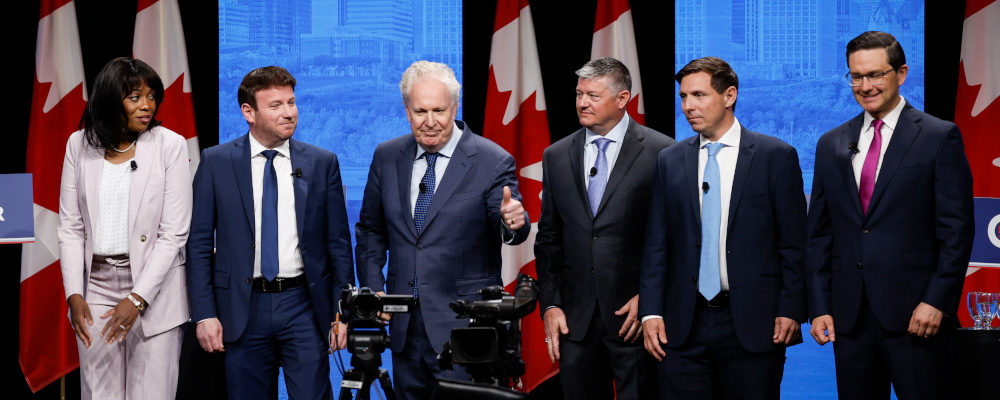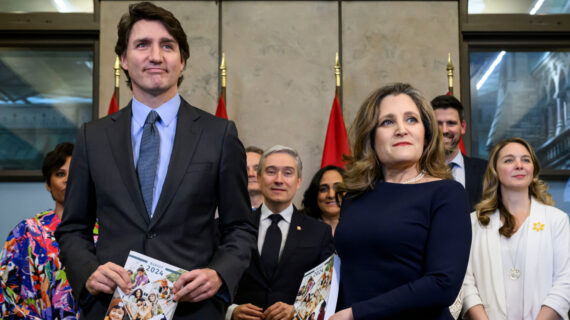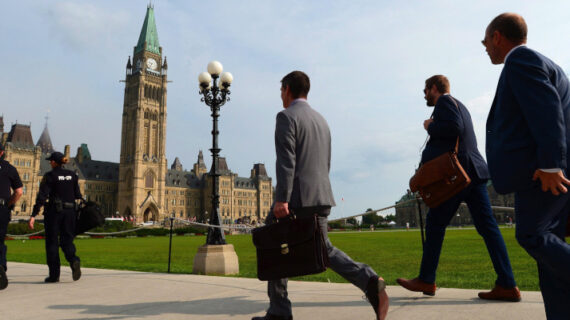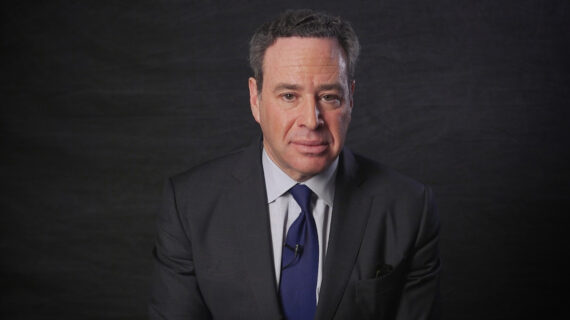This week marks an important anniversary in the history of modern Canadian conservatism. Twenty-six years ago, regular Hub contributor David Frum hosted the Winds of Change conference in Calgary with the goal of “uniting the right” in order to better compete against the Liberal Party for national political power.1The Winds of Right-wing Change in Canadian Journalism https://cjc-online.ca/index.php/journal/article/view/962/868 Although it would require another seven years for the creation of the Conservative Party of Canada, the conference had a major and lasting impact on the world of Canadian Conservative (and conservative) ideas and politics.
The meeting occurred at a moment of political fragmentation on Canada’s Right. It was barely 12 months before the 1997 federal election in which the Liberals were re-elected due in large part to vote-splitting between the Reform Party and the Progressive Conservative Party. Their combined share of the popular vote (38.19 percent) in that election was only a fraction behind the Liberal Party which still won a four-seat majority as a result.
But if the case for greater political cooperation on the divided Right was electorally self-evident, Frum and the other organizers also had ideological ambitions. They sought to push federal Conservatives (including Progressive Conservatives and Reformers) in the direction of a more assertive and self-confident conservatism. As the conference’s manifesto explained:
Our country—which ought to be the richest and happiest in the world—is in trouble. Crushed under debt and taxes, demoralized by perverse social policies, its very existence in question, Canada needs new answers. In the provinces, visionary leaders are offering such answers. But our national politics remain a wasteland of reactionary liberalism: a doctrine without ideas and without principles.
In the realm of ideas, the right has never exerted stronger force in Canada than it does now. However, with two political parties battling for the support of right-of-centre voters, the prospects of a conservative federal government have seldom looked worse.
Canada needs an alternative. We need a national government that cherishes our free-market economy instead of treating it as a goose to be plucked; that respect Canadians’ moral convictions, rather than seeing our convictions as superstitions to be remodelled by Ottawa social engineers. To elect such a national government, we first need unity on the right. To achieve that unity, we must begin by agreeing on the policies that the next federal government should implement.
Unification, in other words, had to be rooted in a common conservative vision for the country as opposed to a narrow exercise of partisan interests. The goal wasn’t just to defeat the Liberals after all. It was to push federal policymaking in a decidedly conservative direction.
The manifesto, therefore, set out a series of ambitious conservative reforms including phasing out federal transfers to the provinces and territories, income splitting for families with children, a universal child benefit for children under age five, significant changes to the Indian Act, and a series of tough-on-crime laws (such as the restoration of the death penalty for the killing of police officers, contract killing or “other grave crimes”). Many of its ideas ultimately found expression in the Harper government in spirit or specifics.
The focus on conservative ideas and policies reflected in large part the attendees of the Winds of Change conference itself. The roughly 100 attendees were mostly drawn from the world of think tanks, academia, and journalism. There was representation from every province including staff-level liaisons from the Harris government in Ontario and even the Bloc Québécois. Alberta’s then-provincial treasurer Stockwell Day chaired the proceedings.
Neither Reform Party leader Preston Manning nor Progressive Conservative Party leader Jean Charest attended. One of the few elected officials at the conference was Stephen Harper, who gave the two-day conference’s most memorable speech which set out the case for building a national coalition rooted in conservative principles. With the benefit of hindsight, his remarks basically served as a “roadmap”2The emerging Conservative coalition https://policyoptions.irpp.org/magazines/the-winner/the-emerging-conservative-coalition/ for the next decade and a half of Canadian Conservative politics.
A major subtext of the conference was generational change. While Harper was in his early 40s and Frum in his mid-30s, a considerable number of the attendees were in their mid and late 20s. This group was generally more ideological than the older generation (including for instance former Alberta Premier Peter Lougheed who criticized3A positive view of conservatism’s future https://archive.macleans.ca/article/1996/5/27/a-positive-view-of-conservatisms-future the conference’s conservative underpinnings) and more prepared to move beyond the personal and partisan squabbles between the Progressive Conservatives and the Reformers. One political observer later described the conference as the moment when “a whole crop of 25-year-olds stepped forward to ease their elders aside and reunite divided conservatives.”4Conservative movement in Quebec is rising https://www.cardus.ca/news/media-coverage/conservative-movement-in-quebec-is-rising/
Although these early efforts to build a unified and self-confident conservatism to challenge the Liberal government and the establishment ideas that it represented didn’t bear immediate fruit, they were, by all accounts, a crucial step on the path to party merger, the creation of the Conservative Party, and the emergence of conservative ideas as a credible alternative to Laurentian liberalism. As Frum recently put it to me: “The Winds of Change conference showed that Ideas do change the world. They just don’t change it right away.”
The similarities to the present moment can be somewhat overstated. There’s probably not an immediate threat of serious centre-right fragmentation and the Conservative Party has won the national popular vote in successive elections. Conservatives (including the Coalition Avenir Québec) also currently govern eight of ten provinces.
There are however some commonalities in the current circumstances including new expressions of right-wing populism, a growing sense of conservative self-doubt, and something of a generational shift occurring in elected Conservative politics and the broader world of Canadian conservatism. As Canadian Conservatives grapple with these issues in the context of the Conservative Party’s ongoing leadership race, there’s wisdom in returning to the spirit of the Winds of Change conference for intellectual inspiration and political insights.
If its chief legacy was to help to lay an intellectual and political foundation for the Harper government’s near-decade in power, now is time for the next generation of Conservatives (and conservatives) to rebuild that foundation. The key lesson from just over a quarter-century ago is to start with ideas.




